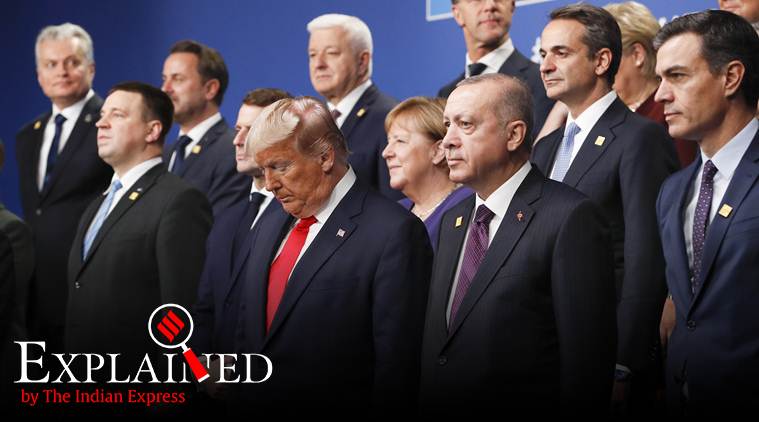There is much that these world leaders have on their plate, including issues related to China and Russia, and the future of arms control — however, news on their two-day meeting has been mostly about the difference and disunity in the alliance
Leaders of member states are gathered in London to celebrate the 70th anniversary of the defence alliance called the North Atlantic Treaty Organisation (NATO).
There is much that these world leaders have on their plate, including issues related to China and Russia, and the future of arms control — however, news on their two-day meeting has been mostly about the difference and disunity in the alliance, with a very limited scope for the convergence of the distinct national priorities of the member countries.
President Emmanuel Macron of France, in particular, has clashed publicly with both President Donald Trump of the United States and Recep Tayyip Erdogan of Turkey.
The founding and purpose of NATO
NATO was founded in 1949, and was meant to ensure collective protection for its members — the United States, Canada, and American allies in Europe — against the threat of possible post-War communist expansion and aggression by the Soviet Union.
The Soviet Union too, formed its own defence and political alliance with Eastern European nations as a counterbalance to NATO — the Warsaw Pact that was signed in 1955. This alliance was disbanded after the dissolution of the Union of Soviet Socialist Republics (USSR) in 1991.
With the collapse of the USSR, NATO lost its essential raisons d’etre, and for most NATO members, the primary concern now is the expansionist ambition of China. In his address to the Summit, NATO Secretary General Jens Stoltenberg underlined to alliance members that “China is coming closer to us”.
NATO has traditionally focused on Russia and the European neighbourhood, and recognises the need to deter “revisionist” and “militarily advanced” Russia, and the threat posed by rogue nations such as North Korea.
An alliance roiled by disunity
President Macron last month described NATO as “brain dead”, and on Tuesday accused Turkey of working with Islamic state proxies. During a 50-minute press conference addressed along with Macron on Tuesday, Trump referred to the French President’s remark about NATO as “very, very nasty” and “very insulting”.
Macron said he stood by his statements. “The common enemy today is the terrorist groups. I’m sorry to say, we don’t have the same definition of terrorism around the table,” he said, referring to Turkey wanting to recognise the Kurdish YPG militia as a terrorist organisation. The militia fought alongside US special forces in Syria against the IS.
Also, President Erdogan has rejected NATO’s military plan for the Baltic nations against Russia, unless it receives support to defeat Syrian Kurds at its borders, something that France and the US do not agree with.
The tensions have come in the backdrop of “Operation Peace Spring” conducted by the Turkish military along the Syrian border in October. A few days before this operation, the Trump administration ordered US troops to withdraw from northeastern Syria where they were supporting their Kurdish allies, leaving the field open for the Turkish forces.
Meanwhile, the host country’s Prime Minister, Boris Johnson, is balancing the campaign for the December 12 elections with trying his best to not be seen with Trump, who is not very popular in the United Kingdom.
Western media reports have suggested that Johnson has consciously avoided scheduling a meeting with the American President. While the two leaders did, in fact, meet at 10 Downing Street on Tuesday night where they reportedly discussed the future of NATO and Syria, no photograph of the two men together has been published yet.
The challenges before NATO
On Wednesday, a video clip emerged in which Canadian Prime Minister Justin Trudeau, Macron, and Johnson appeared to be gossiping about Trump and his “taking a 40-minute press conference off the top”.
During NATO’s Brussels Summit last year, Trump criticised European nations, especially Germany for not spending enough on defence. As per an agreement that was reached in 2014, member nations are supposed to spend up to 2% their GDP on defence on a voluntary basis.
According to NATO data until 2018, the US spends the highest percentage of its GDP (at least 3.5%) on defence, while the Europeans, including the French, the Germans, the Italians, and the Spaniards, spend less than 2%.
The great challenge before NATO is its seeming inability to align the diverging priorities of its member nations. France’s priority at the moment is the eradication of terrorism from northeast Syria, while the US under Trump clearly wants to get out of the Middle East and focus more on the military rise of China.
The challenge is made stronger by the personalities of the leaders — the Europeans are clearly impatient with Erdogan, and Trump’s unpredictability and repeated attacks on European countries and leaders has not endeared him to them.
For all the latest Explained News, download Indian Express App
Source: Read Full Article





